ANATOMY, LOGIC AND LITERACY
- Alphabet formation in Tolkien's Middle-earth
Anne K. Sorknes
![]()
|
In this essay we will first of all look at some phonetics and
illustrate it anatomically. Then we will consider how this
phonetics and anatomy build the foundation for alphabet formation
in Tolkien's Middle-earth. Lastly we will comment on possible
implications for teaching literacy. My source has been Appendix E in Tolkien's "The Lord of the Rings". |
|
Phonetics Phonetics is the science of spoken sounds. The science of describing a sound system for a given language is called phonemics. Such a sound system is a necessary intermediate level before producing a working alphabet for a language. We will start by studying phonetics, because that is what we're working with when we describe sounds anatomically. But we will also look at sound systems and do some thinking on phonemics. |
|
Sounds and anatomy A sound can be described uniquely by 4 facts:
|
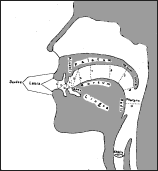 Fig. 1 (large version) |
Consonants in face diagrams I have chosen to deal only with consonants, as I couldn't find much of a system for vowels in the alphabets. I concentrate on those consonants that illustrate the best the basic sound system. The point of articulation for a consonant can be shown by a cut through the mouth cavity, a face diagram (fig. 1). A diagram of all consonants is organized in the same direction as the face diagram, with the labial sounds on the far left, and the sounds made in the throat, on the far right. Further down in this diagram the various modes of articulation are put. I have split up the runes of Daeron's Angerthas and put some of them into such a diagram (fig. 2), and I will refer to them by their number. The diagram is organized phonemically according to Tolkien's sound systems, not strictly phonetically. |
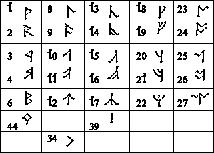 Fig. 2 (full size) |
Suitable for practical exercises! For those who have done some phonetics already, this will be well known. For others it may seem rather theoretical. But try to view it as a way of becoming conscious of how you actually use the different parts of your mouth when you speak, of what is important for a "care-ful ar-ti-cu-la-tion". And do your own testing of those sounds you can see the space (and perhaps the runes) for in the diagram. Perhaps some of them are quite familiar. |
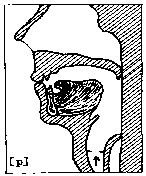 Fig. 3 |
Different ways to make sounds with your lips We start in the outer part of the mouth, with the sounds that are made with your lips closed firmly or loosely. Because they are made with the two lips (labia), they are called bilabial. This indicates their point of articulation. Their mode of articulation is determined by the way the lips are being used. |
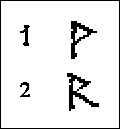 |
Plosives The first mode we will look at, has got three separate phases. First you close your lips firmly together, then you build up pressure inside your mouth behind your lips, and then you release the pressure abruptly like in an explosion. Therefore the sound is called a plosive. (A different name for it is a stop.) It can be voiceless or voiced, i.e. with or without vibrating vocal chords. We recognize the voiceless sound as a p (rune no.1), which then is an voiceless bilabial plosive. It is used in the English word "pin". The voiced sound will be a b (rune no.2), as in the word "bin". The closure phase is shown in the face diagram for p (fig. 3). We see there that the opening up to the nasal cavity is closed. |
 |
Nasals If we close the lips firmly as for a bilabial plosive, but open up for the nasal cavity and let the air glide out through our nose, we get a sound called a nasal. Voiced nasals are the most usual ones, and a voiced bilabial nasal can be recognized as an m (rune no.6), as in "mother". |
|
Fricatives A third way of making bilabial sounds, is to close the lips fairly loosely, so that the air glides out between them and cause friction. Especially in the case of voiced sounds, this friction can be clearly noticed. These sounds are called fricatives. A different name for them is spirants. Bilabial fricatives are used for instance in Spanish (often written with a b, like in "Marbella"), but not in English or Norwegian. |
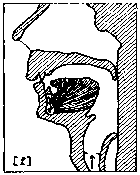 Fig. 4 |
When your teeth meet your lips One of the fricatives we know better from English and Norwegian, is made in a slightly different area than the bilabials. When we don't let the lips come together, but let the upper teeth touch the lower lip, and then make a sound with friction, we get f (rune no.3) as in "ferry" and v (rune no.4) as in "very", for the voiceless and voiced sounds respectively. There is only one phase for these sounds, shown in the face diagram for f (fig. 4). These sounds, made by lips and teeth, are called labio-dentals. It is possible to make labio-dental nasals and plosives as well, but these are rare. |
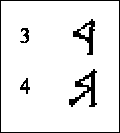
|
Some phonemics As long as we're talking phonetics, we have to meticulously record all tiny differences. In phonemics, on the other hand, the aim is to group sounds that are close to each other, and disregard differences when this won't cause confusion. In a language which uses both bilabial and labio-dental varieties of the same mode of articulation, the different points of articulation are important phonemically as well. But in languages where different modes are produced at different points of articulation, these points can be grouped together to one larger area. In English and Norwegian (and as far as I see, in the Eldarin languages and in Westron) the nasals and plosives are bilabials, while the fricatives are labio-dentals. Phonemically the best solution then is to combine them into one area, labials. We then know that in this case there are small difference as to exactly what point of articulation the labials will have, according to whether they are nasals, plosives or fricatives. |
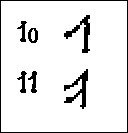 |
More fricatives We will look at even more places where fricatives can be made, and move further into the mouth cavity. By putting the tip of the tongue out between the teeth and make the friction there, we get an inter-dental fricative. This sound is common in English. (Rune no.10 is the voiceless sound, as in "think", and rune no.11 is the voiced sound, as in "this".) Just like the other fricatives we've studied so far, it is made with the tongue kept flat. |
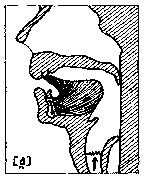 Fig. 5 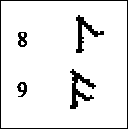 |
Grooved fricatives If we round the tip of the tongue, giving it a small groove in the middle, we get a sort of lisping sound. Such a grooved fricative is more commonly made with the tip of the tongue places against the front teeth, a dental sound. We know this as s, like in the word "sing". (Rune no.34 is one of the runes that are used for the voiceless sound.)  Here we see once more a systematic distribution of the modes of articulation over various points of articulation. The flat fricatives are inter-dental, while the grooved fricatives, the plosives and the other modes are dental. Here it is again sensible phonemically to define a dental area and call all these sounds dentals. English has got both an voiceless dental plosive (rune no.8), t as in "tip", and voiced dental plosive (rune no.9), d as in "dip". The voiced one can be found in the face diagram for d (fig. 5). |
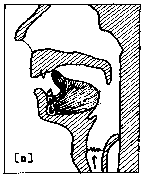 Fig. 6 |
The hard palate The corresponding nasal is n (rune no.12), as in the word "nose". The face diagram (fig. 6) shows a sound more alveolar (formed against the hard palate, the alveoli) than dental, but we include even this in the dental area. 
|
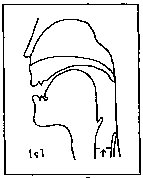 Fig. 7 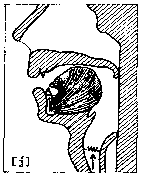 Fig. 8 |
The soft palate We now move so deep into the mouth cavity that we no longer talk about how to position the tip of the tongue, but the back of the tongue. Depending on how far back on the soft palate there is contact with the back of the tongue, the sound is called either palatal or velar. At both of these points both plosives, nasals, and fricatives can be made. The voiceless palatal fricative is close to the sound used in the word "huge". It is more common in German (as the ch-sound in "ich"). A voiced variety of this sound can be similar to what is often written in English as y, as in "you"), but with heavy friction. The point of articulation is shown in the face diagrams (fig. 7 for the German ch-sound, and 8 for the y with heavy friction). Palatal nasals are used in Spanish. In Norwegian dialects we can find both palatal nasals and palatal plosives. |
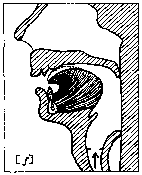 Fig. 9 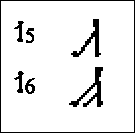 |
Palatal variations There is also a slightly different variety of palatal sounds. Phonetically speaking they are not purely palatal, but palato-alveolar, i.e. made between the hard and the soft palate. Phonemically they can be combined with the others into one palatal area - again provided it will not lead to confusion. The way I understand Tolkien, the different languages had different varieties. Then the language is decisive for how to pronounce a "palatal rune", and only one set of characters is needed. As voiceless grooved palato-alveolar fricative we know the sh-sound, as in "ship" (both this and the German ch-sound are covered by rune no.15). The face diagram (fig. 9) here shows how the sides of the tongue have contact with the palate, while the middle of the tongue forms a groove. The voiced sound is used in French, as in the name "Jeanne d'Arc", but not much in English, except in a few loan words (and not at all in Norwegian). Both this sound and the flat palatal fricative are covered by rune no.16). |
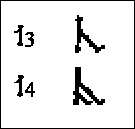 |
Affricates Instead of a pure plosive we here look at something in between (or a combination of) plosive and fricative, called an affricate. The voiceless palato-alveolar affricate is the sound used in the word "chess". The voiced variety is used in the word "jazz". (Both the afficates and the plosives are then covered by the runes 13 - voiceless - and 14 - voiced.) |
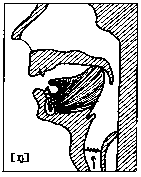 Fig. 10  |
Velar sounds Velar plosives are common in standard English, as these are the ordinary k as in "kit" (rune no.18) and g as in "get" (rune no.19). We know the voiced velar nasal as the ng-sound (rune no.22), as in "sing". Its face diagram shows the velar point of articulation (fig. 10). In English we're not used to finding this sound at the beginning of words, only in the middle or at the end, as in "finger". There are other languages where words can start with "ng", though. 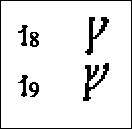
|
  |
Labialized velars: Semi-vowels The velar sounds can also be pronounced with rounded lips, and they are then called labialised. This is what is peculiar about the runes 23-27 (see the diagram fig. 2). The usual way of writing them in English is to write a w next to the labialized sound. This comes from the English w-sound, which is something in between a consonant and a vowel, and is called a semi-vowel. The first sound in the word "we" is a voiced labial semi-vowel (rune nr.44). The y-sound in "young", without any heavy friction, is a voiced palatal semi-vowel (rune no.39). |
|
Logical ordering of the diagram We see from this that the cells in the diagram of the points of articulation are sorted logically in columns from left to right according to the anatomy of the mouth. There is no such logical order for the modes of articulation given by anatomy, but when an order is arbitrarily chosen, all consonants can be placed in rows in the diagram according to this order. We have skipped several modes and many points of articulation, and we have simplified the diagram phonemically. Any consonant would have its fixed position in a complete, strictly phonetical diagram. |
 Fig. 2 (full size) |
Logical alphabet formation The logic of the anatomy is being used, first by tengwar, and later by Daeron's angerthas. We look again at fig. 2, where the numerical order of the runes is broken up to put the runes into the diagram, because we then can see more easily how the alphabet uses the logic. |
|
The principle of "similar sound - similar shape" Each of the vertical columns, containing sounds with the same point of articulation, has characters with the same basic form. Each of the horizontal rows, containing sounds with the same mode of articulation, modifies the basic form in the same way. Sounds that have similarities of pronounciation, will also have characters with similarities of shape. |

|
The different basic forms grouped according to point of articulation The basic form is the voiceless plosive. All runes have got a straight stem with one or more branches slanting out from the stem. Voiceless plosives have one branch to the right of the stem. For the labial plosive, the branch is a closed triangle (rune no.1). For the dental, the branch goes down from the top to the middle of the stem (rune no.8), for the palatal, down from the middle to the bottom of the stem (rune no.13), and for the velar, up from the middle to the top of the stem (rune no.18). For the labialized velar plosive, the branch zigzags a bit down and then back up to the top again (rune no.23). |
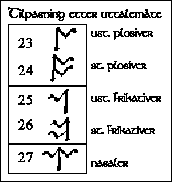 |
Modification of the basic form according to mode of articulation To change plosives into fricatives, the branch is moved from the right to the left. To change voiceless sounds into voiced, an extra branch is added on the same side as the first. To change plosives into nasals, the branch is put on both sides of the stem. This may perhaps give some inconsistency as regards voiceless and voiced nasals, but the reason is that there were no voiceless nasals in these languages, so they wouldn't need separate characters. Special circumstances also necessitated the shift of rune no.6 into the position of rune no.5. |
|
Working out the angerthas-runes logically In order to learn the main runes of angerthas, it is enough to learn runes no.1, no.8, no.13, no.18, and no.23. If you know all these, and then know how to change one group of sounds into another, you can work out how runes no.2-4, no.9-12, no.14-17, no.19-22, and no.24-27 should be written. Because this alphabet uses the "similar sound - similar shape" principle, to a great extent you can reason logically to find out how to pronounce a letter or how to write a sound. |
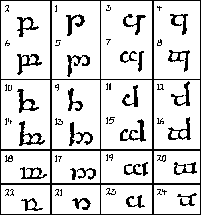 Fig. 11 (full size) |
Tengwar makes use of the system in a more flexible way Tengwar was the first to make use of the "similar sound - similar shape" principle, and angerthas was influenced by this. But tengwar made use of it in an even more flexible way. Angerthas had a set order of its alphabet, and recited it the way we're used to with ours. Tengwar was not recited like that. Instead it had a set of characters which was put into a diagram somewhat similar to the phonemical diagram we put the sounds into (and in here we switch the columns around to be even more similar to the phonemics diagram, see fig. 11). While angerthas had fixed sound values for each rune, the characters of the tengwar were flexible so that the phonemics linguists could employ them according to the needs of each separate language. The same set of characters could be used by languages with widely different sets of sounds. It is obvious that the set is composed according to principles that linguists use even to this day. |
 (full size) |
"Similar sound - similar shape" again The same is true here as with the angerthas: Sounds that have the same similarities of pronounciation, will also have characters with the same similarities of shape. The vertical columns are called series (témar), and the horisontal rows are called grades (tyeller). Each series contains sounds with the same point of articulation, and they have characters with the same basic form. Each grade contains sounds with the same mode of articulation, and they modify the basic forms in the same way. |
 (full size) |
Adaptation of the different basic forms The 24 primary letters of tengwar (see fig. 11) are arranged in 4 series with 6 grades in each. (In addition to these there are some 'additional letters', which we will not cover here.) All primary letters consist of a stem (telco) and a bow (lúva). Grade 1 was regarded as the 'normal' form. Here the stem starts beside the bow and continues below the line where the letter sits. In series I the bow is open and placed on the righthand side of the stem, in series II it is closed, and still on the righthand side. In series III the bow is open and placed on the lefthand side, and in series IV it is closed, and still on the lefthand side. Grade 2 has no modification of the stem, but the bow is doubled. Grades 3 and 4 have the stem raised, and grades 5 and 6 have it reduced. In addition, even grades 4 and 5 have the bow doubled. |
|
Choose the mode according to the needs of each language The point of articulation for each series, and the mode of articulation for each grade, will vary from language to language. Each language chooses the points and modes that are in actual use in that language. The grades can signify a large number of different modes of articulation. The set can be moved around so that the series are placed at different points. If there aren't enough series, one of the series can be reused with e.g. extra dots underneath the characters (Quenya does this). This is very useful, because there can be great variations from one language to another. Each language gets its own mode which defines how this language uses the characters. |
|
Mode for some languages in Middle-earth In the Third Age, however, things had by custom settled down to series I being used for the dental sounds (tincotéma), and series II being used for the labial sounds (parmatéma). For series III and IV there were still larger variations. |
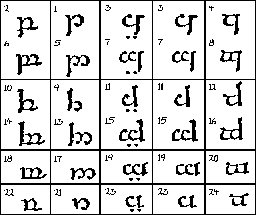 Fig. 12 (full size) |
Quenya Quenya had both palatal sounds (tyelpetéma, which were flat fricatives and plosives), velar sounds, and labialised velar sounds (quessetéma). Series IV was here used for the labialised velars. The velar sounds were reproduced by series III, and the same series - with two dots underneath the characters - was also used for the palatal sounds. (See fig. 12.) |
 Fig. 11 (full size) |
Westron Westron had as its palatal sounds the grooved fricatives and the affricates, and used series III for these. Series IV was then used for the velar sounds (calmatéma). (See fig. 11.) Mode of grades in Westron There had also developed a custom as to what the different grades were to signify. What follows, should describe a mode for Westron. Quenya used the grades slightly different (which we won't cover here) - the language had its own special needs, and the system was meant for flexibility. Grade 1, the normal letters, were usually used for the voiceless plosives. The doubling of the bow made a sound voiced (grades 2, 4, and 5). Raising the stem, like in grades 3 and 4, changed the plosive into a fricative, and shortening the stem, like in grade 5 (and 6), changed the plosive into a nasal. According to this logic, grade 6 would be meant for voiceless nasals. As there were no such sounds in these languages, this grade could be used for something else, and was often used for voiced semi-vowels. |
 (full size) |
Working out the tengwar characters logically Just like with angerthas you needn't learn all characters. You can work out the characters, because the system is organised logically according to the phonemics. (There is one point where the logic of the characters is in conflict with the logic of the anatomy, though: Series I and II have switched places compared to where the sounds are placed in the mouth cavity. Apart from that, the character diagram resembles the phonemics diagram, and we will use the organisation of the phonemics diagram here.) It is enough to learn series I (with all the variations) and grade 1 (with all the normal forms) in the correct mode for the language you want to use. If you know these, then you know how to modify one group of sounds into another, and you can work out what the rest of the character set should be. This alphabet also uses the "similar sound - similar shape" principle. Therefore even here to a great extent you can reason logically to find out both how to pronounce a letter and how to write a sound.  (full size) |
|
Teaching literacy This seems to be a work of genius. And it appeals to my love of systematics. But then the teacher in me comes out and starts talking about literacy teaching and reading techniques, reminding me of the years when I was teaching Norwegian school children (including beginners) to read. Would this system have made things easier for them? And would the Middle-earth system help or hinder Elven and Hobbit children who were trying to learn how to read? |
|
Put the beautiful system behind you To put it short - the logical system is useful for understanding why a letter looks the way it does, but it is something you need to bypass when you learn speed reading. You need to make your character recognition automatic, not something you have to think about for every letter. With time you will learn to recognize whole words, making your reading process more and more automatic. |
|
Confusing the dyslectics For most people this will be a relatively painless process. But there are slow learners, who need a lot of time. And we know that dyslectic people can have quite a struggle to learn to read. (I use the term 'dyslectic' in a general sense, leaving a medical discussion of it to specialists.) And for them this system would only cause extra confusion. Sounds that are easily confused auditively, would be represented by characters that would be equally easily confused visually. For these people the beautiful system would not be very good at all. |
|
Not relevant for Elves or Hobbits In the human societies in Middle-earth this could be a problem. But among the Elves - and among the Hobbits, although for a different reason - I don't think the problem would be relevant at all. Who ever heard of a dyslectic Elf? I think that would be one of the mortal weaknesses the Elves would be spared. Like other human illnesses, it doesn't touch them. I don't even think they would have slow learners. (And any slow learners would certainly have all the time they needed.) What about dyslectic or slow-to-learn Hobbits? There might well be the same percentage of dyslectic Hobbits as of dyslectic people in our modern societies, and similarly with slow learners. But the Hobbits would have their own solution to that problem. It wouldn't be in their nature to pressurize a young Hobbit to suffer the pain of struggling with a painful reading process. They would let him do something more fun instead. Then they would leave the reading to those children who enjoyed discovering the reading process, and who delighted in being able to read their genealogies on their own. |
|
|
What reading process do you use? Observe your own reading if you read tengwar or angerthas. What reading process do you use? Do you use logic to work out the value of the letters/runes, or has your reading process become automatic? Or do you use the book to look up the letter value? I once tested this in a group, with practical examples in Norwegian (making my own Norwegian mode). My observations showed that most people (including myself when I made the examples) chose to look up the letters in the book. Noone used all that lovely logic - it would probably take too much time. First published in Norwegian in Angerthas, the newsletter of Arthedain (the Norwegian Tolkien Society). Later modified for use on the Internet. Translated into English, Literacy section shortened and modified, and the practical examples in Norwegian removed (would have to be remade in English eventually). |
Graphics credited to aks. and Mousepad

Anne K. Sorknes 
To main menu list 
To previous level:
My own writings
Characters from Appendix 3 in "The Lord of the Rings"
Face diagrams from Summer Institute of Linguistics
Background Copyright © Loraine Wauer Ferus